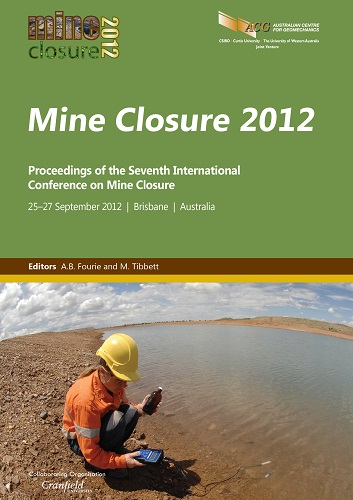Sustainable development for post-closure – a case study of PT Newmont Minahasa Raya

|
Authors: Mamonto, PDL; Sompie, CED; Mekel, PA Paper is not available for download Contact Us |
DOI https://doi.org/10.36487/ACG_rep/1208_26_Mamonto
Cite As:
Mamonto, PDL, Sompie, CED & Mekel, PA 2012, 'Sustainable development for post-closure – a case study of PT Newmont Minahasa Raya', in AB Fourie & M Tibbett (eds), Mine Closure 2012: Proceedings of the Seventh International Conference on Mine Closure, Australian Centre for Geomechanics, Perth, pp. 279-293, https://doi.org/10.36487/ACG_rep/1208_26_Mamonto
Abstract:
Improving economic and community welfare is one of the community development programmes that have been conducted by PT Newmont Minahasa Raya (PTNMR) since 1996. Infrastructure development in each village has substantially improved the condition of villages surrounding the mine to that of an economic district. The aim of PTNMR’s community development programmes was to improve infrastructure in each village so that transportation infrastructure (roads, bridges that connect economic activities) could be facilitated. After mine closure, community development programmes were aimed to achieve sustainable development of each community. The programmes have three main pillars: sustainable environment, economy and social. The first was based on developing the reclamation forest, development of artificial coral reef using reef balls, and mangrove forest rehabilitation. The second, to achieve economic sustainability, included developing a tourism area and creating new industry; while the social component included strengthening community foundations. In 2011, a Condition of Social Economic of the Community Surrounding the Mine of PTNMR, revealed that the local economy was developing and improving after closure. The average income of a family in the Buyat village in 1994, before the mine started, was IDR 1,475,500 = USD 155.80 (currency rate: 1 USD = 9,470.55 IDR). After the mine closure period in 2011, the average income had improved to IDR 21,557,856 (USD 2,269.13). The average expenses of each family at the village before mining were IDR 2,050,175 (USD 216.48) and after closure, the average expenses per family reached IDR 15,364,788 (USD 1,622.38). The ownership of permanent housing has improved in East Ratatotok to more than 69% from 2.2% when the mine began. The condition of the houses has also improved from only 22% of cement-floor houses in 1994 to more than 95% cement, tile and wood floor houses in 2011. The sizes of the houses also increased from just 20 m2 in 1994, to an average 61.15 m2 in 2011. The total number of villages in Ratatotok and Buyat area was only three villages (1986) when the mine started. The area has developed to 18 villages after closure in 2011.
References:
ACNielsen (2004) ACNielsen Indonesia. Evaluation of the Socio-Economic Conditions of the Surrounding Area of a Mining Project in Minahasa, ACNielsen Indonesia, pp. 11–79.
ANZMEC (2000) Australian and New Zealand Minerals and Energy Council. Strategic Framework For Mine Closure, Minerals Council of Australia.
Dresner, P. (2002) The Principles of Sustainability, 2nd ed., Earthscan, London, pp. 1–2.
Faculty of Economy Research Team, Unsrat (2011) Condition of Social Economic of the Community Surrounding the Mine of PT Newmont Minahasa Raya in 2011, Faculty of Economy, University Sam Ratulangi, Manado, pp. 3–79.
Hertanto, A.W. (2008) Contract of Work, A Study of Civil Law, Indonesian Scientific Journal Database (2012), viewed 12 July 2012, .
Kojansow, J., Rondonuwu, A.B., Sompie, D., Lalamentik, L.T.X. and Lennon, D. (2009) Fish Colonization on Reef Balls Over 9 Years at Ratatotok Peninsula in North Sulawesi, Indonesia.
Lennon, D., Kojansow, J., Sompie, D. and Emor, D. (2009) Fish Colonization of Reef Balls Over 8 Years, 9th CARAH, Brazil, Reef Ball Australia, PT Newmont Minahasa Raya.
Lorax Environmental (2002) Minahasa Mine Closure Plan, PT Newmont Minahasa Raya.
Mansur, A., Sompie, D., Wiryanto, K. and Kojansow, J. (2010) Mining Gold and Inherit Green Gold For Sustainable Environment, Bogor Agricultural University and SEAMEO BIOTROP, PT. Newmont Minahasa Raya, Indonesia.
Minister of Forestry of Republic of Indonesia (2009) Regulation Number: P.60/Menhut-II/2009 Assessment Guidelines for Forest Reclamation Success Criteria, Minister of Forestry RI, 30 p.
Minister of Forestry of Republic of Indonesia (2010) Decision Number: SK.435/Menhut-II/2010 Termination of Borrow to Use Forestry Area Agreement for PT Newmont Minahasa Raya, Minister of Forestry RI, 9 p.
Mustard, A. (2009) Striking Gold Buyat Bay North Sulawesi – Underwater Photography Scuba Ocean, Dive Photo Guide, viewed 26 February 2009, .
Newmont Mining Corporation (2011) The Journey Towards Sustainability: Newmont’s Global Sustainability Reports for 2011, viewed 20 January 2012, .
PTNMR (1994) PT Newmont Minahasa Raya. Environmental Impact Assessment, Main Report, Proposed Minahasa Gold Project, Minahasa and Bolaang Mongondow, North Sulawesi, Indonesia, pp. 4-166–4-212.
Sedyono, C.H. (24/10/2007) Current Situation of CSR in Indonesia, Asian Development Bank Institute (2012) Capacity Building and Training, viewed 25 January 2012, .
Swift, T. and Zadek, S. (2002) Corporate Responsibility and the Competitive Advantage of Nation, Accountability for the Copenhagen Centre, pp. 1–10.
© Copyright 2024, Australian Centre for Geomechanics (ACG), The University of Western Australia. All rights reserved.
View copyright/legal information
Please direct any queries or error reports to repository-acg@uwa.edu.au
View copyright/legal information
Please direct any queries or error reports to repository-acg@uwa.edu.au